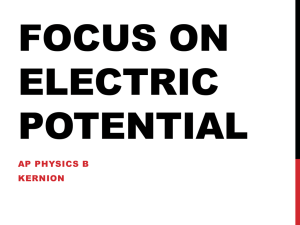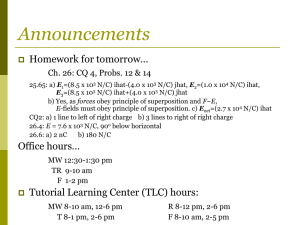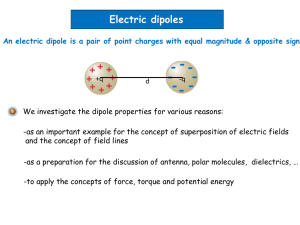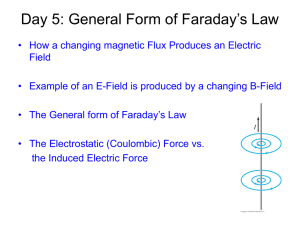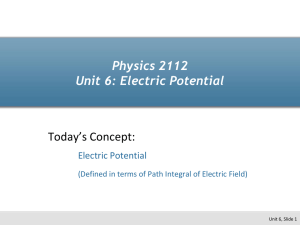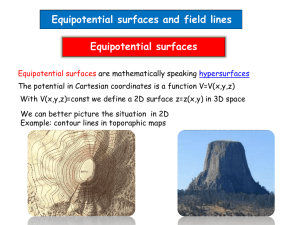electric potential difference
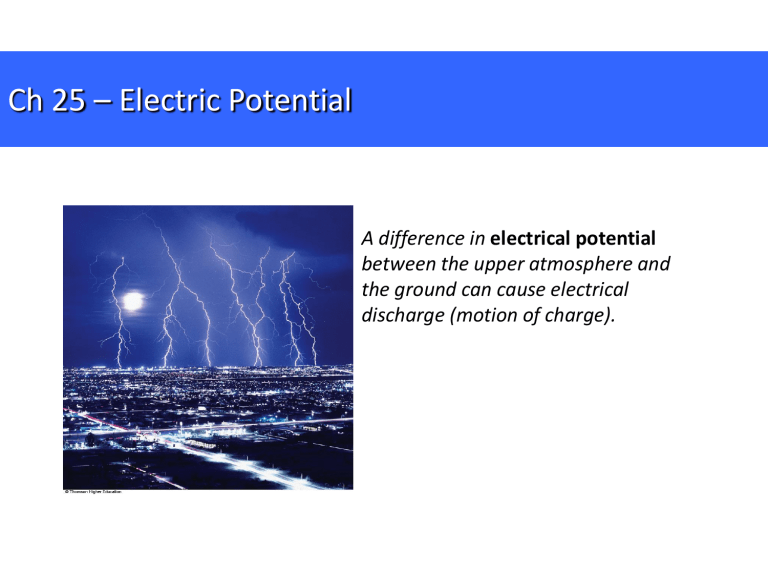
Ch 25 – Electric Potential
A difference in electrical potential between the upper atmosphere and the ground can cause electrical discharge (motion of charge).
Ch 25 – Electric Potential
So far, we’ve discussed electric force and fields .
Now, we associate a potential energy function with electric force.
This is identical to what we did with gravity last semester.
gravity
F g
G m
1 m
2 r
2 r
ˆ
g
G m r
2 r
ˆ
U g
G m
1 m
2 r
electricity
F e
k e
E
k e q
1 r
2 q
2 r q
2 r
ˆ
?
Ch 25.1 – Electric Potential and Potential Difference
• Place a test charge, q
0
, into an E-field. The charge will experience a force:
F
q
0
E
• This force is a conservative force.
• Pretend an external agent does work to move the charge through the
E-field.
• The work done by the external agent equals at least the negative of the work done by the E-field .
Ch 25.1 – Electric Potential and Potential Difference
• Let’s introduce a new symbol:
d s
• We’re talking about moving charges through some displacement.
• The “
ds
” vector is a little tiny step of displacement along a charge’s path.
Ch 25.1 – Electric Potential and Potential Difference
• If q
0 moves through the E-field by a little step some work:
ds , the E-field does dW
E
field
F
d s
• As the E-field performs this work, we say that the potential energy of the charge-field system changes by this amount.
• This is the basis for our definition of the potential energy function .
Ch 25.1 – Electric Potential and Potential Difference
• If q
0 moves through the E-field by a little step some work:
ds , the E-field does dW
E
field
F
d s
dU
dW
E
field
F
d s
q
0
E
d s
U
U
B
U
A
q
0
B
A
E
d s
Ch 25.1 – Electric Potential and Potential Difference
U
U
B
U
A
q
0
B
A
E
d s
The change in electrical potential energy of a charge-field system as the charge moves from A to B in the field.
The integral accounts for the motion of the charge through a 1-D path. It’s called a “ path ” or “ line ” integral .
Ch 25.1 – Electric Potential and Potential Difference
U
U
B
U
A
q
0
B
A
E
d s
The change in electrical potential energy of a charge-field system as the charge moves from A to B in the field.
Because electric force is conservative, the value of the integral does not depend on the path taken between A and B .
Ch 25.1 – Electric Potential and Potential Difference
Potential Energy refresher:
Potential Energy measures the energy a system has due to it’s configuration .
U
U
B
U
A
q
0
B
A
E
d s
The change in electrical potential
energy of a charge-field system as the charge moves from A to B in the field.
We always care about changes in potential energy – not the instantaneous value of the PE.
The zero-point for PE is relative. You get to choose what configuration of the system corresponds to PE = 0.
Ch 25.1 – Electric Potential and Potential Difference
• What we’re about to do is different than anything you saw in gravitation.
• In electricity, we choose to divide q
0 out of the equation.
V
U q
0
B
A
E
d s
• We call this new function, Δ V , the “ electric potential difference .”
Ch 25.1 – Electric Potential and Potential Difference
V
U q
0
B
A
E
d s
Potential difference between two points in an Electric Field.
• This physical quantity only depends on the electric field.
• Potential Difference – the change in potential energy per unit charge between two points in an electric field.
• Units: Volts, [V] = [J/C]
Ch 25.1 – Electric Potential and Potential Difference
V
U q
0
B
A
E
d s
Potential difference between two points in an Electric Field.
• Do not confuse “ potential difference ” with a change in “ electric potential energy .”
• A potential difference can exist in an E-field regardless the presence of a test charge.
• A change in electric potential energy can only occur if a test charge actually moves through the E-field.
Ch 25.1 – Electric Potential and Potential Difference
• Pretend an external agent moves a charge, q , from A to B without changing its speed. Then:
W
U
But:
V
U q
0
W
q
V
Ch 25.1 – Electric Potential and Potential Difference
• Units of the potential difference are Volts:
1 V
1 J/C
• 1 J of work must be done to move 1 C of charge through a potential difference of 1 V.
Ch 25.1 – Electric Potential and Potential Difference
• We now redefine the units of the electric field in terms of volts.
1 N/C
1 V/m
E-field units in terms of volts per meter
Ch 25.1 – Electric Potential and Potential Difference
• Another useful unit (in atomic physics) is the electron-volt.
1 eV
1.60
10
-19
C
V
1.60
10
-19
J The electron-volt
• One electron-volt is the energy required to move one electron worth of charge through a potential difference of 1 volt.
• If a 1 volt potential difference accelerates an electron, the electron acquires 1 electron-volt worth of kinetic energy.
Quick Quiz 25.1
Points A and B are located in a region where there is an electric field.
How would you describe the potential difference between A and B ? Is it negative, positive or zero?
Pretend you move a negative charge from A to B . How does the potential energy of the system change? Is it negative, positive or zero?
Ch 25.2 – Potential Difference in a Uniform E-Field
Let’s calculate the potential difference between A and B separated by a distance d .
Assume the E-field is uniform, and the path, s , between A and B is parallel to the field.
V
B
A
E
d s
Ch 25.2 – Potential Difference in a Uniform E-Field
Let’s calculate the potential difference between A and B separated by a distance d .
Assume the E-field is uniform , and the displacement, s , between A and
B is parallel to the field .
V
B
A
E
d s
V
B
A
Eds cos
1
V
E
B
A ds
V
Ed
Ch 25.2 – Potential Difference in a Uniform E-Field
V
Ed
The negative sign tells you the potential at B is lower than the potential at A .
V
B
< V
A
Electric field lines always point in the direction of decreasing electric potential.
Ch 25.2 – Potential Difference in a Uniform E-Field
Now, pretend a charge q
0 moves from A to B .
The change in the charge-field PE is:
U
q
0
V
q
0
Ed
If q
0 is a positive charge, then Δ U is negative.
When a positive charge moves down field, the charge-field system loses potential energy.
Ch 25.2 – Potential Difference in a Uniform E-Field
Electric fields accelerate charges… that’s what they do.
What we’re saying here is that as the E-field accelerates a positive charge, the charge-field system picks up kinetic energy.
At the same time, the charge-field system loses an equal amount of potential energy.
Why? Because in an isolated system without friction, mechanical energy must always be conserved .
Ch 25.2 – Potential Difference in a Uniform E-Field
If q
0 is negative then Δ from A to B .
U is positive as it moves
U
q
0
V
q
0
Ed
When a negative charge moves down field, the charge-field system gains potential energy.
If a negative charge is released from rest in an electric field, it will accelerate against the field.
Ch 25.2 – Potential Difference in a Uniform E-Field
Consider a more general case.
Assume the E-field is uniform, but the path, s , between A and B is not parallel to the field.
V
B
A
E
d s
Ch 25.2 – Potential Difference in a Uniform E-Field
Consider a more general case.
Assume the E-field is uniform, but the path, s , between A and B is not parallel to the field.
V
B
A
E
d s
E
B
A d s
E
s
U
q
0
V
q
0
E
s
Ch 25.2 – Potential Difference in a Uniform E-Field
V
E
s
If s is perpendicular to E (path C B), the electric potential does not change.
Any surface oriented perpendicular to the electric field is thus called a surface of equipotential , or an equipotential surface .
Quick Quiz 25.2
The labeled points are on a series of equipotential surfaces associated with an electric field.
Rank (from greatest to least) the work done by the electric field on a positive charge that moves from A to
B , from B to C , from C to D , and from D to E .
EG 25.1 – E-field between to plates of charge
A battery has a specified potential difference Δ V between its terminals and establishes that potential difference between conductors attached to the terminals. This is what batteries do.
A 12-V battery is connected between two plates as shown. The separation distance is d = 0.30 cm, and we assume the E-field between the plates is uniform. Find the magnitude of the E-field between the plates.
EG 25.1 – Proton in a Uniform E-field
A proton is released from rest at A in a uniform E-field of magnitude 8.0 x
10 4 V/m. The proton displaces through 0.50 m to point B , in the same direction as the E-field. Find the speed of the proton after completing the 0.50 m displacement.
